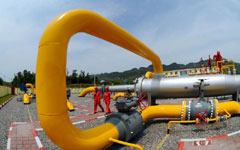China-Turkmenistan co-op consolidates energy corridor
Updated: 2014-08-28 16:09
(Xinhua)
|
|||||||||||
Cement energy corridor
China's cooperation with Turkmenistan is an integral part of the central Asian all-win cooperation, represented by the construction of the China-central Asia natural gas pipelines spreading on the territories of Turkmenistan, Kazakhstan, Uzbekistan and China.
The 1,830-km-long line C, parallel to Line A and Line B, started to transport natural gas to China in June at the Turkmen-Uzbek border and runs through central Uzbekistan and southern Kazakhstan before reaching China's northwestern region of Xinjiang.
|
 |
|
 |
By then, the combined gas transmission of the pipelines is set to reach the target of 65 billion cubic meters per year.
Vowing to develop a long-term, stable and mutually beneficial energy strategic partnership, China and Kazakhstan agreed in May to speed up the construction of more cross-border crude oil and gas pipelines.
The network of crude oil and gas pipelines has brought about substantial benefits to all the countries concerned.
The China-Turkmenistan gas pipelines have transmitted more than 90 billion cubic meters of natural gas over the past few years. China has become the top trading partner and natural gas export market for Turkmenistan for the last three years.
Meanwhile, China and Uzbekistan last week signed deals worth over $6 billion, ranging from trade, loan to the construction of natural gas pipelines and treatment plants.
Central Asia is considered the world's second largest source of oil and gas after the Persian Gulf with over 30 billion tons of exploitable crude and more than one trillion cubic meters of natural gas.
Energy cooperation has prompted rapid growth of trade volume between China and four central Asian countries, namely Kazakhstan, Uzbekistan, Tajikistan and Kyrgyzstan, which increased 13 percent year on year to $40.2 billion in 2013, data from China's Ministry of Commerce showed.
China's initiatives of building the Silk Road economic belt and a 21st-century maritime Silk Road were put forward by Chinese President Xi Jinping during his two separate visits to central Asia and Southeast Asia last fall.
Related Stories
Turkmenistan president launches book in Chinese 2014-05-12 15:33
China to produce locomotives for Turkmenistan 2013-11-24 17:02
Region urged to facilitate tourism 2013-09-10 08:41
Deal ensures supplies of natural gas 2013-09-05 01:39
Energy partners boost gas supplies 2013-09-04 01:41
China, Central Asian countries open 3rd gas line 2014-06-16 09:46
Today's Top News
Girl, 9, kills shooting range instructor
IMF chief Lagarde investigated in graft case
1,400 children exploited in UK town
China, Russia enhance military ties
Turkish FM elected as premier
Putin, Poroshenko hold first bilateral meeting
Panda fakes pregnancy for more buns
Two execs at VW's ventures in China probed for 'serious' violations
Hot Topics
Lunar probe , China growth forecasts, Emission rules get tougher, China seen through 'colored lens', International board,
Editor's Picks

|

|

|

|

|

|





